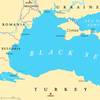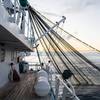Workboat 2024: A Ton of Energy
There’s plenty to go around for everyone, no matter it comes from.
I will admit that attending the 2024 Workboat Show in the Big Easy just ten days after settling into the MarineNews Editor’s chair (for this, the second time around) had my full attention. The event typically evokes the specter of drinking from the proverbial fire hose in routine times, but attending and digesting all it has to offer, right out of the gate, makes the task just little bit edgier. Ultimately, last week’s trade show exuded terrific energy, from exhibitors to attendees alike. Indeed, energy turned out to be the catch word of the week.
I’m normally a “glass half full” kind of guy, but I detected just a bit of contrary energy from the opposite side of the spectrum in New Orleans. The program that is primarily focused around the machinations and business of the workboats that fuel U.S. ports and energy also took place in the choppy wake of the November presidential election. With the winner also making a clean sweep of both the House and Senate, while also previously vowing to kill offshore wind projects, the future of domestic offshore wind energy is anything but certain. That said; the future of offshore energy, in my opinion, is very bright. It is here where I repeat that my glass remains half full. Let me explain why:
The new administration in Washington, D.C. can be described in many ways. Slow out of the gate is not one of them. The President-elect quickly nominated North Dakota Governor Doug Burgum as the next Secretary of the Interior. For his part, Burgum has always been a strong advocate for energy, particularly in way of domestic production and streamlined regulations. Separately, Chris Wright, founder and CEO of Liberty Energy, is the President-elect’s pick to be Secretary of Energy. The two, if confirmed, will arguably form the most knowledgeable energy team ever to fill those roles. For those industry stakeholders hoping to reverse current federal energy policies, this is good news indeed.
Drilling down to the local level, individual states – like Massachusetts, for example – are proposing and passing clean energy bills that are aimed at bolstering and encouraging future offshore wind energy contracts. No longer worried, apparently, about impinging on the ocean view from the Hyannis port Kennedy compound, the Commonwealth is plowing full steam ahead, aiming for that elusive “carbon net zero” future. That sort of effort will be critical if federal support and funding dries up in the coming year(s). And, it surely looks like that will be the case.
ABS Offshore Wind Forum
It's not all bad news for wind. At last Monday’s 5th Annual ABS Offshore Wind Forum, offshore wind advocates at OCEANTIC Network painted 2023 as “the second-best year ever for the global offshore wind industry.” With a total of 75 GW of global offshore wind capacity in operation by year’s end, GWEC’s rolling ten-year future outlook, assuming that all goes according to plan, that number could skyrocket to 487 GW deployed by 2033. The OCEANTIC presentation further insists, “New capacity increased 24% on the previous year, a growth rate the Global Wind Energy Council expects to see continue up to 2030, if the present increase in policy momentum continues.” More good news, indeed.
All that said, offshore wind development here at home remains tepid, and since the New Orleans-based Workboat Show caters largely to a domestic, Jones Act audience, that reality was of great concern to some attendees. For the operators of Jones Act offshore support vessels, the advent of a new pro-energy boss in Washington is a double-edged sword. The slowly developing crew transfer vessel (CTV) newbuild programs face much uncertainty in the face of waning federal support for the wind industry. Nevertheless, the ABS panel discussion members found common ground in the belief that a robust newbuild program can be supported, but with certain caveats. Chief among these is the need to build offshore support vessels that are capable of multiple missions.
Offshore energy takes many forms; wind, tidal, solar, wave – and yes; oil and gas. All of these require offshore support vessels of all sizes and configuration. For those investors wavering on going all in on offshore wind in U.S. waters, the promise of a robust revival of offshore oil is just the ticket that might provide a good dose of intestinal fortitude. And, that’s because a design that incorporates myriad missions for these important workboats also ensures that when one sector is depressed, another will surge to meet the gap.
We need offshore energy – where it comes from is beside the point – and that energy must be facilitated and supported by workboats. U.S.-flag and Jones Act compliant workboats. A vessel designed solely to meet the needs of offshore wind is eventually likely to find itself idle as it awaits the next project to begin. It’s a dilemma not unlike that faced by traditional salvage vessel operators, whose owners sit on vast fleets of equipment and boats awaiting the next oil spill or black swan event at sea. But, if those vessels aren’t built here, they will certainly be built elsewhere, and eventually find their way onto the outer continental shelf of these United States.
The ABS forum panelists, including National Ocean Industries Association (NOIA) and Offshore Marine Service Association (OMSA) executives, agreed on many things, including the need for predictability in federal and local policy, lease procurements and newbuild vessels to support future development. But OMSA CEO Aaron Smith’s concerns dig deeper into the equation, where he cited the 51 foreign flag vessels competing directly against U.S. flag assets in this hemisphere. OMSA represents more than 140 domestic member companies, including approximately 60 firms that own and operate marine service vessels.
Those flag of convenience vessels, Smith says, operate by one set of rules, and the U.S. assets by another, far more expensive model. In many of these sectors – anchor handlers and survey vessels among them – the Jones Act does not protect U.S. operators. It’s a battle that Smith has been fighting for many years in Washington, one which adds just one more aspect of uncertainty to domestic workboat operators – and by default, their local vendors, equipment OEMs, and virtually every other phase of the domestic waterfront.
You could write a book while sorting through the myriad discussions and issues brought out at both the forum presentation and panel discussion, but the one theme that I thought had particular merit was the need for versatile, multi-use service vessels, built in series to both hold down costs but also to foster standardization throughout the offshore energy sectors. No doubt that kind of vessel will cost a bit more, but it will also remain on-hire for significantly longer than something built to service a single, narrow niche market. Isn’t that exactly what investors want?
Cyber Security in the Maritime Sector
There was much more going last week in New Orleans, of course. Notably, the ABS, MARLINK and Maritime Reporter & Engineering News-sponsored panel discussion focusing on Cyber Security in the Maritime Sector brought to light just one more danger lurking on the collective waterfront. The need to tighten up IT and communications infrastructure, especially in a world where the seemingly insatiable thirst for data is being transmitted and monitored in thousands of ways, has never been more urgent.
Providing unique insight into the matter were U.S. Coast Guard Rear Admiral Wayne Arguin, Assistant Commandant for Prevention Policy, Dain Detillier, EVP of LNG Operations at Harvey Gulf, Stewart Alpert, Chief Information Security Officer at Hornblower, Angeliki Zisimatou, Director of Cyber Security at ABS, and Philip Bannerman, VP of Sales America at MarLink. The panel was moderated under the steady hand of Greg Trauthwein, Editor and Publisher of Maritime Reporter & Engineering News. As the U.S. Coast Guard rolls out new rules regarding this all-important topic, the panel discussion also made clear that the risks involved impact every corner of the maritime world, and indeed, constitute a safety challenge like no other.
Coast Guard Admiral Arguin made it clear that cyber security was a top issue at headquarters, and that the regulations governing what will soon be mandatory – and not just best practices, for some – will be every bit as important as, for example, preventing oil spills. How that rulemaking will play out in real life has yet to be defined. During the Q&A that followed the discussions, Arguin himself admitted that the nation’s fifth uniformed service was not yet fully staffed for such an effort, but that there were few things on their plate that were more important.
Meanwhile: back at the Morial Convention Center …
One of the nicer aspects of attending my first Workboat Show since 2019 is that everything on display seemed shiny and new. For me, it was also an opportunity to see old friends and colleagues, and meet many new ones. The crowd seemed younger – or maybe I’m just A LOT older – and although a few people had switched jobs and/or employers, I was encouraged by how many people I still knew. For the record, I was NOT the oldest person at the Massachusetts Maritime Academy’s alumni cocktail reception, but it was touch-and-go for the first twenty minutes.
Yep: Energy – my assessment only – was the central theme of last week’s industry event(s) in New Orleans. To that end, there was plenty of energy evident in all the attendees. At the same time, it became clear that Offshore Energy is Offshore Energy. There are many kinds, and plenty to go around for all stakeholders. Those operators who position and build their equipment to address multiple sectors on a single platform will be in the best position to take advantage of that reality.
One of my favorite quotes, most often attributed to President John F. Kennedy, asserts that “a rising tide lifts all boats.” For the domestic offshore workboat market, we don’t yet know which energy tide will lift the market in the months and years to come. Nevertheless, I am confident that this tide will come in, and when it does, it will be a strong spring tide. My glass therefore always remains half full.
***************************
Joseph Keefe is the Editor of MarineNews magazine, and a 1980 graduate of the Massachusetts Maritime Academy. A licensed mariner, his career has spanned more than 40 years in the maritime, shipping and energy sectors. His work has been featured in more than 15 industry periodicals. Today, he contributes to all of the New Wave Media tiles, as needed.














